Page 133 of 398

’06 AVALON_U (L/O 0508)
125
OPERATION OF INSTRUMENTS AND
CONTROLS
Lights, Wipers and Defogger
Headlights and turn signals126
. . . . . . . . . . . . . . . . . . . . . . . . . . . . . . . . . .
Emergency flashers 132
. . . . . . . . . . . . . . . . . . . . . . . . . . . . . . . . . . . . \
. . . . .
Instrument panel light control 132
. . . . . . . . . . . . . . . . . . . . . . . . . . . . . . . .
Front fog lights 133
. . . . . . . . . . . . . . . . . . . . . . . . . . . . . . . . . . . . \
. . . . . . . . .
Interior light 133
. . . . . . . . . . . . . . . . . . . . . . . . . . . . . . . . . . . . \
. . . . . . . . . . . .
Front personal lights 133
. . . . . . . . . . . . . . . . . . . . . . . . . . . . . . . . . . . . \
. . . .
Rear personal lights 134
. . . . . . . . . . . . . . . . . . . . . . . . . . . . . . . . . . . . \
. . . .
Illuminated entry system 135
. . . . . . . . . . . . . . . . . . . . . . . . . . . . . . . . . . . . \
.
Windshield wipers and washer 136
. . . . . . . . . . . . . . . . . . . . . . . . . . . . . . .
Rear window and outside rear view mirror defoggers 139
. . . . . . . . . . .
SECTION 1� 5
Page 147 of 398
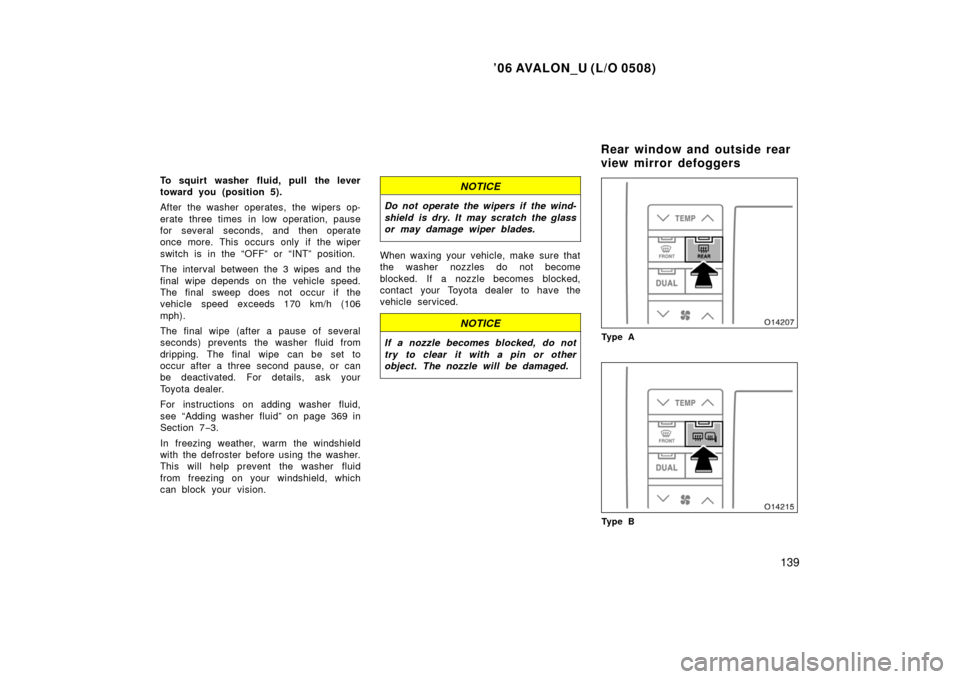
’06 AVALON_U (L/O 0508)
139
To squirt washer fluid, pull the lever
toward you (position 5).
After the washer operates, the wipers op-
erate three times in low operation, pause
for several seconds, and then operate
once more. This occurs only if the wiper
switch is in the “OFF” or “INT” position.
The interval between the 3 wipes and the
final wipe depends on the vehicle speed.
The final sweep does not occur if the
vehicle speed exceeds 170 km/h (106
mph).
The final wipe (after a pause of several
seconds) prevents the washer fluid from
dripping. The final wipe can be set to
occur after a three second pause, or can
be deactivated. For details, ask your
Toyota dealer.
For instructions on adding washer fluid,
see “Adding washer fluid” on page 369 in
Section 7−3.
In freezing weather, warm the windshield
with the defroster before using the washer.
This will help prevent the washer fluid
from freezing on your windshield, which
can block your vision.NOTICE
Do not operate the wipers if the wind-
shield is dry. It may scratch the glass
or may damage wiper blades.
When waxing your vehicle, make sure that
the washer nozzles do not become
blocked. If a nozzle becomes blocked,
contact your Toyota dealer to have the
vehicle serviced.
NOTICE
If a nozzle becomes blocked, do not
try to clear it with a pin or other
object. The nozzle will be damaged.Ty p e A
Ty p e B
Rear window and outside rear
view mirror defoggers
Page 148 of 398
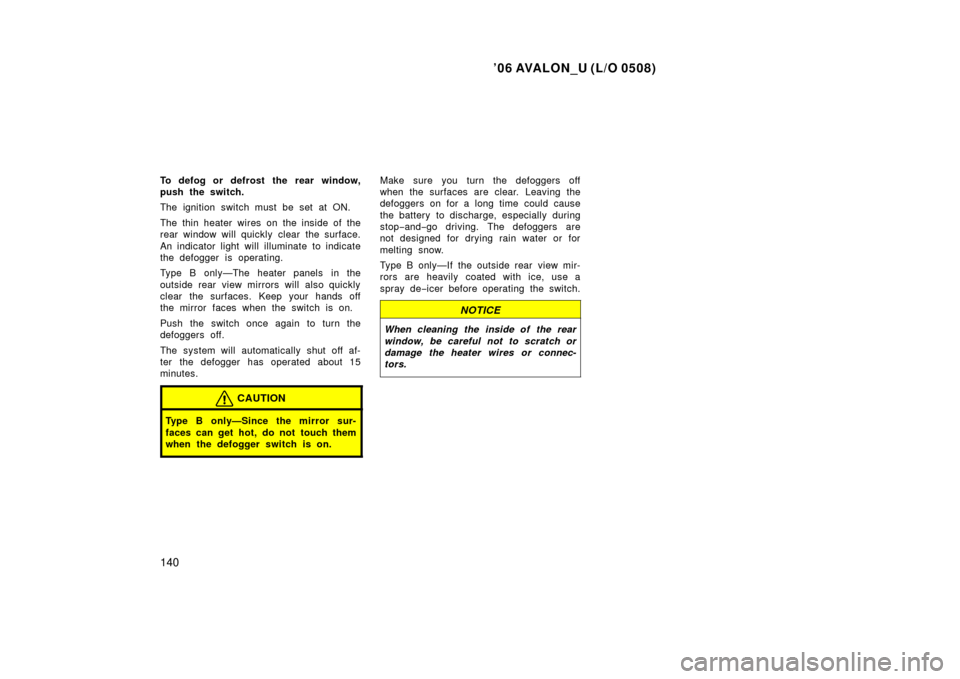
’06 AVALON_U (L/O 0508)
140
To defog or defrost the rear window,
push the switch.
The ignition switch must be set at ON.
The thin heater wires on the inside of the
rear window will quickly clear the surface.
An indicator light will illuminate to indicate
the defogger is operating.
Type B only—The heater panels in the
outside rear view mirrors will also quickly
clear the surfaces. Keep your hands off
the mirror faces when the switch is on.
Push the switch once again to turn the
defoggers off.
The system will automatically shut off af-
ter the defogger has operated about 15
minutes.
CAUTION
Type B only—Since the mirror sur-
faces can get hot, do not touch them
when the defogger switch is on.
Make sure you turn the defoggers off
when the surfaces are clear. Leaving the
defoggers on for a long time could cause
the battery to discharge, especially during
stop−and− go driving. The defoggers are
not designed for drying rain water or for
melting snow.
Type B only—If the outside rear view mir-
rors are heavily coated with ice, use a
spray de −icer before operating the switch.
NOTICE
When cleaning the inside of the rear
window, be careful not to scratch or
damage the heater wires or connec-
tors.
Page 201 of 398

’06 AVALON_U (L/O 0508)
193
TONE AND BALANCE
For details about your system’s tone and
balance controls, see the description of
your own system.
Type 1 and type 2 audio systems utilize
FOCUS� and TruBass � audio enhance-
ment technologies, under license from
SRS Labs, Inc., in all mode except AM
radio mode.
Tone
How good an audio program sounds to
you is largely determined by the mix of
the treble, midrange, and bass levels. In
fact, different kinds of music and vocal
programs usually sound better with differ-
ent mixes of treble, midrange (type 3
only) and bass.
Balance
A good balance of the left and right stereo
channels and of the front and rear sound
levels is also important.
Keep in mind that if you are listening to
a stereo recording or broadcast, changing
the right/left balance will increase the vol-
ume of one group of sounds while de-
creasing the volume of another. YOUR RADIO ANTENNA
Your vehicle has an antenna printed on
the inside of the rear window.
NOTICE
Putting a film (especially a conductive
or metallic film) on the rear wi
ndow
will noticeably reduce the sensitivity
of the radio.
YOUR AUDIO DISPLAY
The audio information is displayed on the
center display.
Page 236 of 398
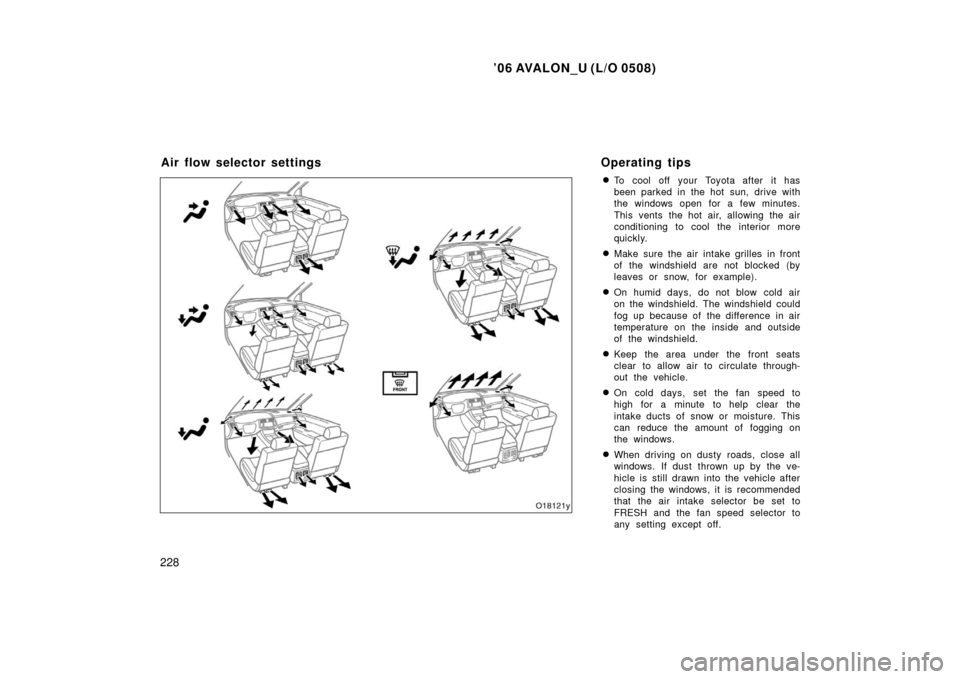
’06 AVALON_U (L/O 0508)
228�
To cool off your Toyota after it has
been parked in the hot sun, drive with
the windows open for a few minutes.
This vents the hot air, allowing the air
conditioning to cool the interior more
quickly.
�Make sure the air intake grilles in front
of the windshield are not blocked (by
leaves or snow, for example).
�On humid days, do not blow cold air
on the windshield. The windshield could
fog up because of the difference in air
temperature on the inside and outside
of the windshield.
�Keep the area under the front seats
clear to allow air to circulate through-
out the vehicle.
�On cold days, set the fan speed to
high for a minute to help clear the
intake ducts of snow or moisture. This
can reduce the amount of fogging on
the windows.
�When driving on dusty roads, close all
windows. If dust thrown up by the ve-
hicle is still drawn into the vehicle after
closing the windows, it is recommended
that the air intake selector be set to
FRESH and the fan speed selector to
any setting except off.
Air flow selector settings
Operating tips
Page 237 of 398

’06 AVALON_U (L/O 0508)
229
�
If following another vehicle on a dusty
road, or driving in windy and dusty
conditions, it is recommended that the
air intake selector be temporarily set to
RECIRCULATE, which will close off the
outside passage and prevent outside
air and dust from entering the vehicle
interior.
Heating
For best results, set controls to:
—For automatic operation
Press in the “AUTO” button.
Temperature— To the desired
temperature
Air intake—FRESH (outside air)
Air conditioning—OFF
—For manual operation
Fan speed— To the desired fan speed
Temperature— To w a r d s high temperature
Air intake—FRESH (outside air)
Air flow—FLOOR
Air conditioning—OFF
�For quick heating, select recirculated
air for a few minutes. To keep the
windows from fogging, select fresh af-
ter the vehicle interior has been
warmed.
�Press the “A/C” button on for dehumidi-
fied heating.
�Choose floor/windshield air flow to heat
the vehicle interior while defrosting or
defogging the windshield. Air conditioning
For best results, set controls to:
—For automatic operation
Press in the “AUTO” button.
Temperature— To the desired
temperature
Air intake—FRESH (outside air)
Air conditioning—ON
—For manual operation
Fan speed— To the desired fan speed
Temperature— Towards low temperature
Air intake—FRESH (outside air)
Air flow—PANEL
Air conditioning—ON
�For quick cooling, select recirculated
air for a few minutes.
Page 241 of 398
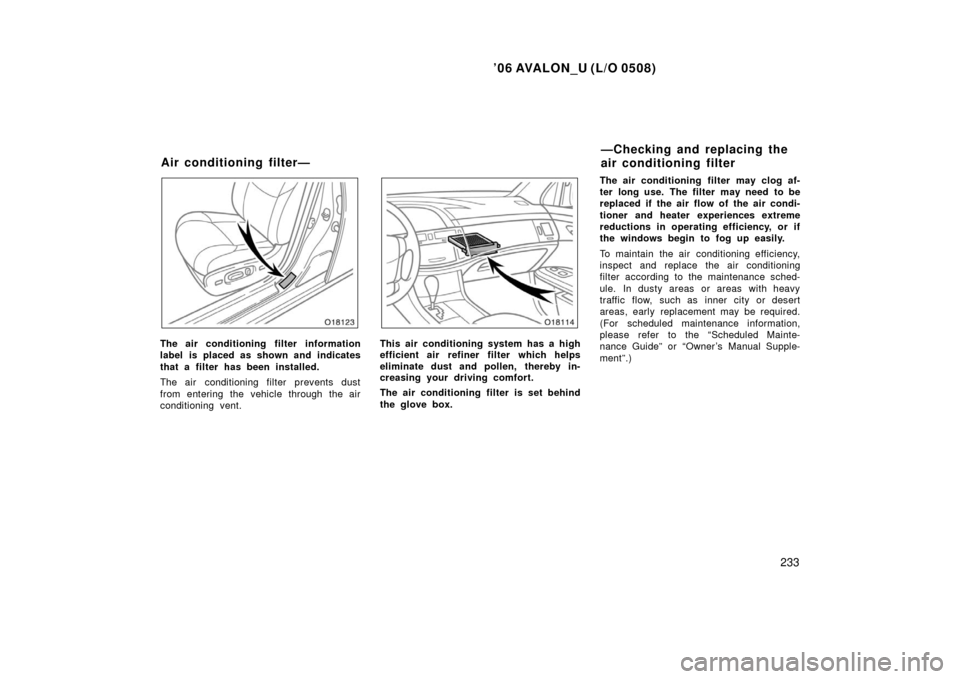
’06 AVALON_U (L/O 0508)
233
The air conditioning filter information
label is placed as shown and indicates
that a filter has been installed.
The air conditioning filter prevents dust
from entering the vehicle through the air
conditioning vent.This air conditioning system has a high
efficient air refiner filter which helps
eliminate dust and pollen, thereby in-
creasing your driving comfort.
The air conditioning filter is set behind
the glove box.The air conditioning filter may clog af-
ter long use. The filter may need to be
replaced if the air flow of the air condi-
tioner and heater experiences extreme
reductions in operating efficiency, or if
the windows begin to fog up easily.
To maintain the air conditioning efficiency,
inspect and replace the air conditioning
filter according to the maintenance sched-
ule. In dusty areas or areas with heavy
traffic flow, such as inner city or desert
areas, early replacement may be required.
(For scheduled maintenance information,
please refer to the “Scheduled Mainte-
nance Guide” or “Owner ’s Manual Supple-
ment”.)
Air conditioning filter—
—Checking and replacing the
air conditioning filter
Page 272 of 398
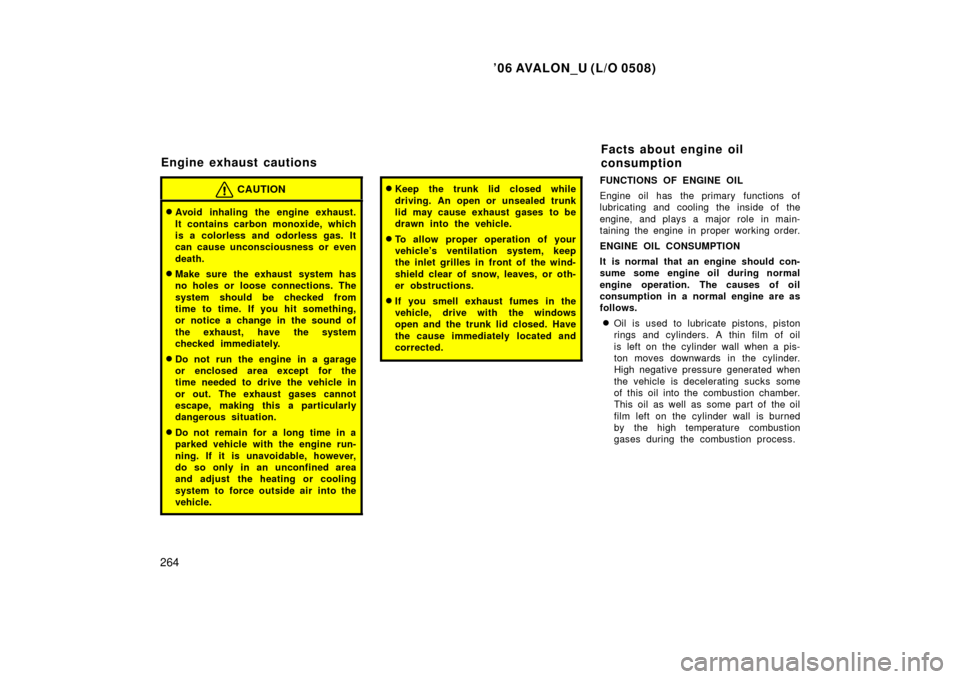
’06 AVALON_U (L/O 0508)
264
CAUTION
�Avoid inhaling the engine exhaust.
It contains carbon monoxide, which
is a colorless and odorless gas. It
can cause unconsciousness or even
death.
�Make sure the exhaust system has
no holes or loose connections. The
system should be checked from
time to time. If you hit something,
or notice a change in the sound of
the exhaust, have the system
checked immediately.
�Do not run the engine in a garage
or enclosed area except for the
time needed to drive the vehicle in
or out. The exhaust gases cannot
escape, making this a particularly
dangerous situation.
�Do not remain for a long time in a
parked vehicle with the engine run-
ning. If it is unavoidable, however,
do so only in an unconfined area
and adjust the heating or cooling
system to force outside air into the
vehicle.
�Keep the trunk lid closed while
driving. An open or unsealed trunk
lid may cause exhaust gases to be
drawn into the vehicle.
�To allow proper operation of your
vehicle’s ventilation system, keep
the inlet grilles in front of the wind-
shield clear of snow, leaves, or oth-
er obstructions.
�If you smell exhaust fumes in the
vehicle, drive with the windows
open and the trunk lid closed. Have
the cause immediately located and
corrected.
FUNCTIONS OF ENGINE OIL
Engine oil has the primary functions of
lubricating and cooling the inside of the
engine, and plays a major role in main-
taining the engine in proper working order.
ENGINE OIL CONSUMPTION
It is normal that an engine should con-
sume some engine oil during normal
engine operation. The causes of oil
consumption in a normal engine are as
follows.
�Oil is used to lubricate pistons, piston
rings and cylinders. A thin film of oil
is left on the cylinder wall when a pis-
ton moves downwards in the cylinder.
High negative pressure generated when
the vehicle is decelerating sucks some
of this oil into the combustion chamber.
This oil as well as some part of the oil
film left on the cylinder wall is burned
by the high temperature combustion
gases during the combustion process.
Engine exhaust cautionsFacts about engine oil
consumption